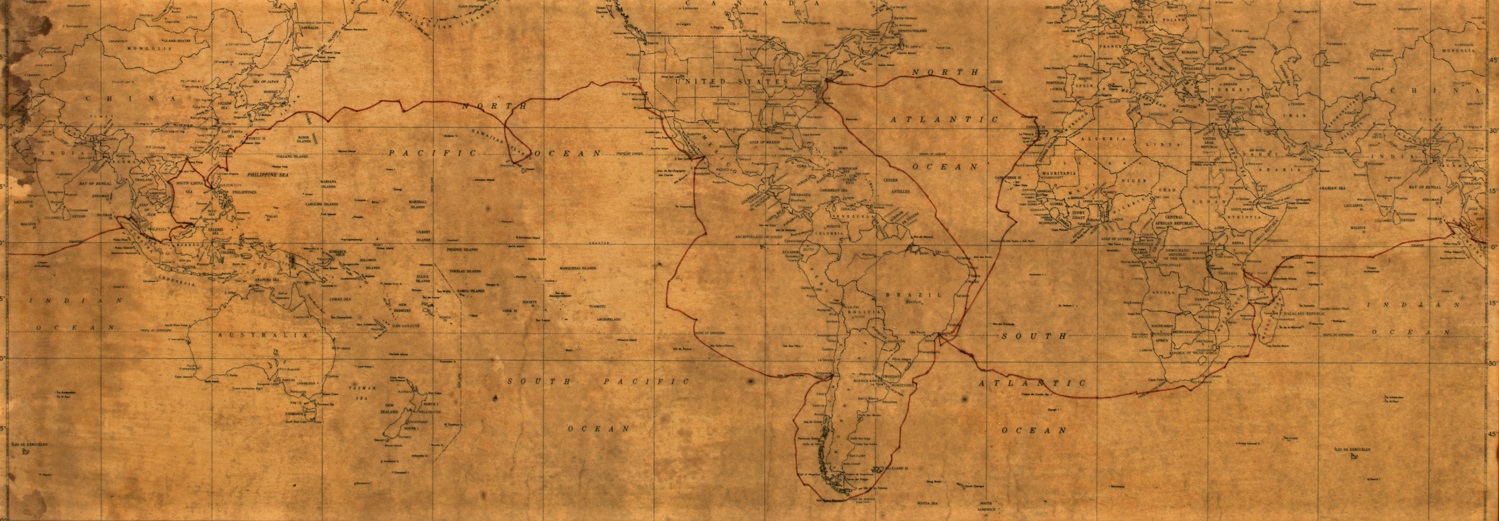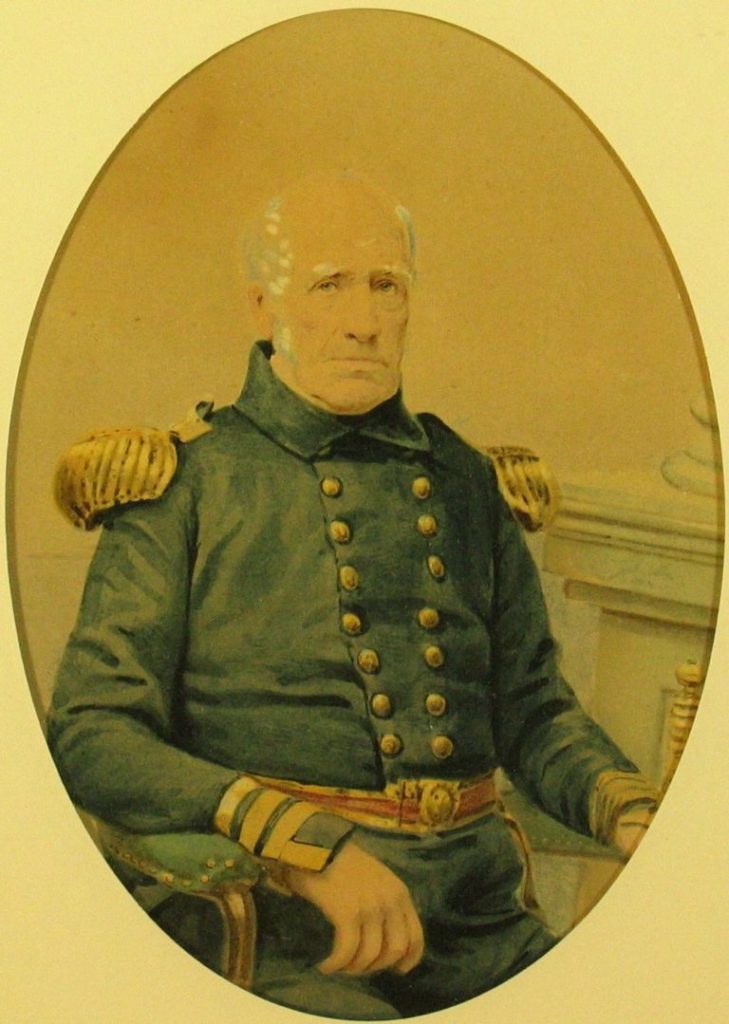
7:30 a.m. April 17, 1844. If you were standing at the top of the Cape Henry lighthouse in Virginia that morning, you might have caught a glimpse of her.
About five miles to the north, in the entrance to Chesapeake Bay, there was USS Constitution. She was under sail, heading east-southeast out of the bay and into the open ocean. Within a half hour, she would disappear from the lighthouse’s view, lost in the hazy weather that was rolling in that morning.
It was the first time in nearly two years since “Old Ironsides” had been underway on the ocean. Deeply in need of repairs that the navy couldn’t afford, she languished in Norfolk, Virginia until an aging captain looking for another chance at command rescued Constitution. Standing on the quarterdeck of the 47-year-old ship that morning, 65-year-old Captain John Percival was the oldest to ever command USS Constitution. A year earlier, he had convinced the Secretary of the Navy that he could get the ship back in sailing condition under budget, and he had delivered. Initial estimates to repair the ship had ranged upward of $70,000, but Percival completed the work for $10,000.
Departing the Chesapeake, “Old Ironsides” swung her bow to the northeast and headed for New York. It should have been a relatively simple passage, one she’d made many times before, but within hours of being back on the open ocean, the crew was shortening sail to deal with heavy winds and seas that would plague them for the entire trip to New York.
The difficult passage was a prelude to what would arguably become the grandest adventure of Constitution’s career. After a month in New York taking on additional crew and supplies, Constitution departed on May 29, 1844 for a two-year circumnavigation of the globe that took her to 24 ports of call from Brazil to Borneo and back. But like that first leg to New York, the remainder of the trip was often fraught with difficulties that tested both the ship and crew.
Unlike her previous tasks as a warship with a specific mandate, the mission that became known as her World Cruise was a mix of goals that reflected the multi-faceted role the United States was coming to play on the world stage. Percival was to expand U.S. trade through agreements with several different nations, including some that had not previously engaged with the United States. He was to scout out possible future coaling stations for the country’s nascent steam navy. And USS Constitution was to show the flag, demonstrating America’s commitment to protecting its nation’s merchant and whaling fleets around the world while investing in new opportunities.
Along the way, the ship and her crew participated in several significant events that portended future roles for the United States, but overall the voyage’s success was debatable. Percival failed to achieve his primary tasks in some ports, and conflicts arose in other ports that made matters worse instead of better.
The Atlantic stretch of the voyage involved delivering the United States’ new minister to the recently independent nation of Brazil. Henry Wise, his family, and several servants dominated the Great Cabin from New York to Rio, with stops at the Atlantic isles of the Azores, Madeira, and Tenerife. From Rio, Constitution sailed for Africa, making stops in Madagascar, Mozambique and Zanzibar throughout the fall of 1844.
On November 26 1844, Constitution set sail for the five-week, 4,500-mile voyage across the Indian Ocean from Zanzibar to Sumatra. Throughout the voyage, the crew was stricken with dysentery and other illnesses. Most of it was likely from water that was brought on at one of the African ports. Between the ship’s departure from Zanzibar on November 26, 1844 to the arrival in Singapore on February 2, 1845, more than 60 of the 450 crew had been relegated to sick bay, and eight crew members died.
After stops at Sumatra and Singapore, Constitution crossed the South China Sea to the island of Borneo. Among the primary goals of the voyage was to negotiate a trade agreement with the Sultanate of Brunei on Borneo for pepper and coal, but the negotiation was a disaster. Thanks in part to a poor interpreter, the Americans left the meeting with the sultan’s representatives empty-handed. They misunderstood that the British had signed an exclusive deal with the island nation just three weeks before Constitution’s arrival. But while the British had been in Brunei, there was no agreement that cut out the prospects for American trade. Had Constitution remained longer and had Percival more patiently attempted to continue negotiations, Brunei’s expectations might have become clearer.
Captain John Percival had been known as “Mad Jack” for his impetuous nature in the merchant service. In some ways his boldness and leadership matched Constitution’s need for such a long voyage, but that same attribute would prove troublesome in the delicate diplomatic maneuvering that was required in some of the ports.
In Touron Bay in Cochin China (today’s DaNang, Vietnam), Percival created a diplomatic incident bordering on war in his efforts to free a French bishop and missionary who had been arrested. The ship anchored there hoping to take on water and provisions, but the Americans met a cold reception from locals wary of western incursion.
During a tour of the ship arranged to mollify several local officials, an interpreter slipped a note to Percival, written four days earlier by Dominique Lefèbvre, a French bishop in Vietnam, and addressed to an unnamed admiral of regional French Naval Forces. In it, Lefèbvre said he was being held in the nearby city of Hue and appealed for rescue because he was “condemned to death without delay.”
The Nguyễn Emperor, Thiệu Trị, had a history of capturing priests and missionaries, threatening to kill them, and then releasing them out of the country. Five of them had been released to a French warship three years earlier. Unfortunately, there is no indication that Percival or his crew were at all familiar with the backdrop of Vietnamese politics or the history of these abductions, which were aimed to drive the French religious influence out of the area without sparking all-out war with France.
Percival stormed ashore with 80 armed men and demanded to see the local leader, but was unable to determine exactly who that was. He insisted on delivering letters demanding Lefèbvre’s release. Unable to identify a local authority, Percival took several prisoners and returned to the ship for a standoff that lasted two weeks. Constitution’s crew seized several local fishing boats as well, and several Vietnamese drowned trying to recapture them from the Americans. When additional Vietnamese ships began to arrive in the bay in defense of their town and neighboring fort from the Americans, Percival eventually abandoned his effort. He released his hostages and left the bay without having secured the release of Lefèbvre, but the events had bitterly angered the Vietnamese. Percival’s rash belligerent actions were not well received by either the Secretary of Navy or the other regional American diplomats seeking to re-engage American trade in Touron Bay.
From Touron Bay, Constituton sailed to Macao and Canton, where Constitution spent the summer of 1845. Trade agreements with China, made by American navy ships three years earlier, were now ratified and Percival was kept busy dealing with complaints from American merchants and local issues associated with the new trade.
After stopping at Manila and Batan in the Philippines, Constitution sailed for the independent nation of Hawaii, arriving there on November 16, 1845 after six weeks at sea. Hawaiians were open to engaging with the Americans, but fearful of their ability to defend their island nation against other incursions. Constitution’s Marine Lieutenant Joseph W. Curtis was asked to survey Oahu for the best places for defensive fortifications. Curtis recommended Pearl Harbor and its narrow river entrance as a good position for improvement and defense.
After sailing from Hawaii to Monterrey, Percival was ordered to Mazatlán in anticipation of the looming war with Mexico. Percival argued that the ship was not in condition to serve in Mexico, and Constitution departed Mazatlán on April 22, 1846, just three weeks before the United States declared war. Leaving Mexico, Constitution made the long passage south, stopping at Valparaiso before rounding Cape Horn and reentering the Atlantic Ocean. After a stop in Rio de Janeiro at the beginning of August, 1846, the ship headed for home.
Constitution arrived in Boston on September 27, 1846, officially concluding her world voyage. Over the course of two years, the ship had sailed more than 52,000 miles and visited more than 20 different ports. Constitution would remain in Boston, undergoing extensive repairs in the following year. By the end of 1848, the ship was redeployed to the Mediterranean for a third time.
After leaving USS Constitution on October 8, 1846, Captain John Percival never commanded another ship. It’s unclear how much his behavior in Vietnam and other issues with the voyage contributed to the end of his career, or whether it was merely a question of his age. He lobbied for a position as Commandant of the Boston Navy Yard, but was rejected. He retired to Dorchester, Massachusetts, and died in 1862 at age 83. Percival was buried in his hometown of Barnstable on Cape Cod. In 1939, town officials erected a large memorial tablet at the cemetery commemorating Percival’s role as Constitution’s captain during the World Cruise.

This June, the USS Constitution Museum will commemorate the 175th anniversary of USS Constitution’s World Cruise.
The Author(s)
Carl Herzog
Public Historian, USS Constitution Museum
Carl Herzog is the Public Historian at the USS Constitution Museum.